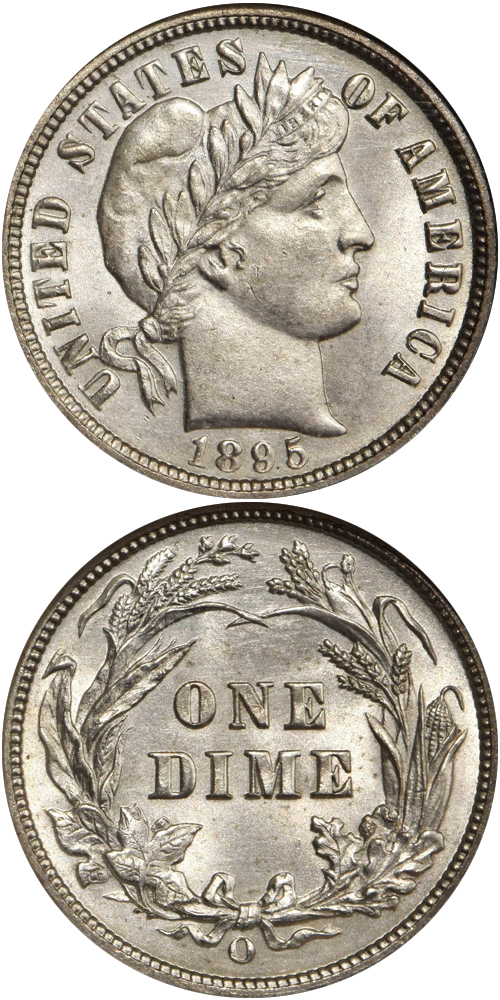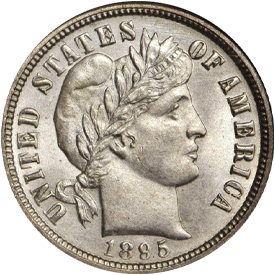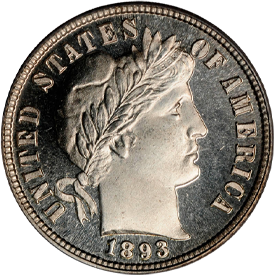Designed by: Charles E. Barber
Issue Dates: 1892-1916
Composition: 90% silver, 10% copper
Diameter: 17.9 mm
Weight: 2.50 grams (38.58 grains)
Edge: Reeded
Business Strike Mintage: 504,317,075
Proof Mintage: 17,353
In 1892 the dime, quarter, and half dollar denominations were redesigned. A Liberty Head motif common to all three denominations made its appearance the same year. Known as the Barber dime, the ten-cent denomination featured on the obverse Miss Liberty facing right, her hair in a Phrygian cap and wearing a laurel wreath, with the word LIBERTY in tiny letters in a band above her forehead. The inscription UNITED STATES OF AMERICA surrounds, and the date is below. The reverse is of the same design used earlier and features a large wreath enclosing ONE DIME. There was no room for the motto IN GOD WE TRUST on the coin, so it was omitted. It is not generally realized that the obverse design of the dime differs from that of the quarter and half dollar, in that the latter denominations have stars around the obverse periphery.
While there are a number of scarcities and rarities in the 1892-1916 series, the exceedingly rare 1894-S dime being famous among them, there are enough common dates that the type set collector will encounter no difficulty acquiring an example in any desired grade from Good through AU. Uncirculated pieces are elusive, although hardly rare, while superb Uncirculated coins are more difficult to find. Proofs were minted each year from 1892 to 1915 (but not 1916) for collectors, and these can be obtained with some searching.
Further Reading
In 1892 a new dime design made its appearance: the Barber type, named by collectors after its designer, Charles E. Barber, the chief engraver of the Philadelphia Mint. For many years they were sim ply called Liberty Head dimes. The "Barber" designation came later when numismatists began investigating the origins of various pieces. Up until the 1940s such coins sometimes were referred to as "Morgan'' dimes (also larger denominations of the same design were called "Morgan'' quarters and half dollars) despite the prominent presence of the B initial on the neck truncation.
The design is a rather classic one, reminiscent in a way of the contemporary Liberty Head nickel. Barber dimes, quarters, and half dollars are rather simple, yet beautiful in design, and as such they have been favorites of modern-day collectors. However, this popularity was not in evidence back in 1892. At the time of release the design was not appreciated by collectors, nor did the public approve. At one time (in 1895) sentiment was so strong concerning what was considered to be a lack of artistry in coin designs that a committee of sculptors and artists took matters into their own hands and submitted their own ideas to the Treasury Department! Nothing ever came of the effort, however.
The Mint evidently decided to be regular about coining Barber dimes, for beginning in 1892 pieces of this denomination were methodically produced each year at Philadelphia, New Orleans, and San Francisco. To be sure, the coinage did skip 1904-O (not produced), but apart from this, the mintages are quite consistent, as a glance at the Guide Book or other references will reveal. Barber dimes were made through 1916. Proofs were produced each year from 1892 through 1915 (but not in 1916) at the Philadelphia Mint and were sold to collectors.
David Lange, a California numismatist, once called my attention to several articles in the "Collectors' Clearinghouse" section of Coin World. One article included a discussion of Barber dimes by John W. McCloskey, which appeared on page 76 of Coin World issue of July 2, 1980.
John McCloskey noted that Barber dimes are characterized by two obverses, the first used from 1892 to 1900 and characterized by rounded ends to the tips of the leaves in the wreath on the head. The leaf below the second S in STATES is distant from the letter and the N in UNITED seems to touch the ribbon. The second obverse variant, used on pieces dated from 1901 to 1916, is characterized by pointed tips to the leaves in the wreath on the head. The leaf below the second S in STATES is closer to the letter S and the N in UNITED is not joined to the ribbon.
Two reverses are noted. The Type A was used beginning in 1892 and continued as late as 1905 and is characterized by the thin right ribbon on the wreath below the bow. The tail of the right ribbon arches up to follow the fold in the ribbon near the right hand. The Type B reverse, introduced in 1901 and continued through the end of the series in 1916, is characterized by the thick right ribbon on the wreath below the bow. The tail of the right ribbon has an extra fold on the underside of the ribbon near the end.
There is one super-rarity among Barber dimes, the 1894-S, of which only 24 pieces were coined. There are two main versions of why only a few were made. The first has it that 24 pieces were struck for die testing purposes, with the anticipation that a larger coinage would come later. The anticipated larger coinage never materialized. The second story goes that at the end of the year 1894 there was a shortage in the coining account books of $2.40, so 24 pieces were struck in order to make the account come out even.
Whichever story is true, the 1894-S is one of the stellar rarities in American coinage. Only about a dozen specimens can be traced with certainty today, and nearly all of these are in Uncirculated grade with prooflike surfaces. Some have even been designated as presentation Proofs. Certainly, the Mint director knew that rarities were being produced, for his daughter, Hallie Daggett, retained two specimens, both prooflike, and sold them in later years to San Francisco dealer Earl Parker.
Over the years I have handled a number of 1894-S dimes. The first one of these was purchased by me for James F. Ruddy (who was later to become my business associate) for the then-staggering sum of $4,750 at the Empire Sale held by Stack's of New York City in 1957. Three or four others have been involved in various transactions since that time.
Scarcities among other issues in the Barber series are the so-called 1893/2 overdate, the 1894-0, the 1895, and the 1895-0. The branch mint issues of 1896 and 1897 are scarce in Uncirculated grade, and 1901-S is considered elusive in the same state.
Among Proof issues, 1914 (with a reported mintage of just 425 pieces) is the rarest. Close on its heels is the 1915, of which just 450 were struck. Slightly higher priced is the 1895, not because it is extremely rare (880 Proofs were made, an average mintage for a Proof of the era), but because regular issues (business strikes) of this date are rare. Years ago, the 1895 Proof was priced at multiples of other Proofs. In recent years the demand for Barber coins as types, rather than as dates, has leveled out the pricing structure, and the 1895 is scarcely noticed as being different.
Uncirculated examples can be collected of all dates and mintmarks of Barber dimes, but as noted, certain issues are elusive. The only full set I have ever seen of Choice Uncirculated and Choice Proof dimes (which did not include the 1894-S) is that purchased a number of years ago from Joel Rettew and Barry Stuppler, California dealers. Many of the branch mint coins had prooflike surfaces. Obviously, the set required many years to put together.
In worn grades, Barber dimes are available in conditions from About Good onward. An interesting feature of the design is that given even a modest amount of wear, the highest part of Miss Liberty's headband loses its detail. Thus, the word LIBERTY, the sharpness of which is the key to whether a coin is Fine, Very Fine, or Extremely Fine, was lost after a given piece spent just a few years in circulation. Therefore, in Extremely Fine grade, representing a piece with sharp details and full LIBERTY, Barber dimes are much, much scarcer than is apparent.
By contrast, the earlier Liberty Seated design is such that the word LIBERTY on these pieces, also used as a determinant of condition, is more protected, and pieces could endure a much longer time in circulation before the letters were worn away. The same situation is true with Barber quarters and half dollars. Apart from a discussion of this given by me at various earlier times, I have never seen even a whisper of this intriguing situation in print elsewhere.
Let me explain in more detail by comparing two issues, one a Liberty Seated dime and the other a Barber dime. Take the 1890 Liberty Seated dime (of which 9,911,541 were struck) and the 1909 Barber dime (of which 10,240,650 were made). Although no one knows how many worn examples of each exist, I will guess that with some searching in every safe deposit box, attic, basement partition, and nook and cranny in the United States we could come up with 10,000 worn specimens of each. Of course, this is just a guess. Perhaps 11,253 1890 dimes exist whereas 21,647 Barber dimes exist (because Barber dimes are a more modern issue, and because collectors were more aware of such pieces during our own century, more proportionally were saved). In any event, imagine that we have in front of us 10,000 worn examples each of the 1890 dime and the 1909 dime.
The 1890 dimes would probably break down into approximately the following proportions: dimes in Fair to Good grade 5,000 pieces, Very Good to Fine grade 2,500 pieces, and Very Fine to AU grade, 2,500 pieces. On the other hand, of the Barber dimes, the vast majority, say 7,000, would be in Fair to Good condition, 2,000 would be in Very Good to Fine condition and only 1,000 in Very Fine to AU preservation. The point of this is that higher grade Barber dimes with sharpness are much, much, much scarcer than their low catalogue values over the years have indicated.
I once posed as a challenge to the students in one of my seminars conducted for American Numismatic Association members that anyone interested endeavor to form a set of Barber dimes, quarters, or half dollars in Extremely Fine grade. At the time-in the 1970s and early 1980s-catalogue prices were very low. I consider these to be great sleepers. Prices have a way of adjusting themselves, and once people start looking for them and the rarity is verified, perhaps the opportunity of finding bargains will be lost.








